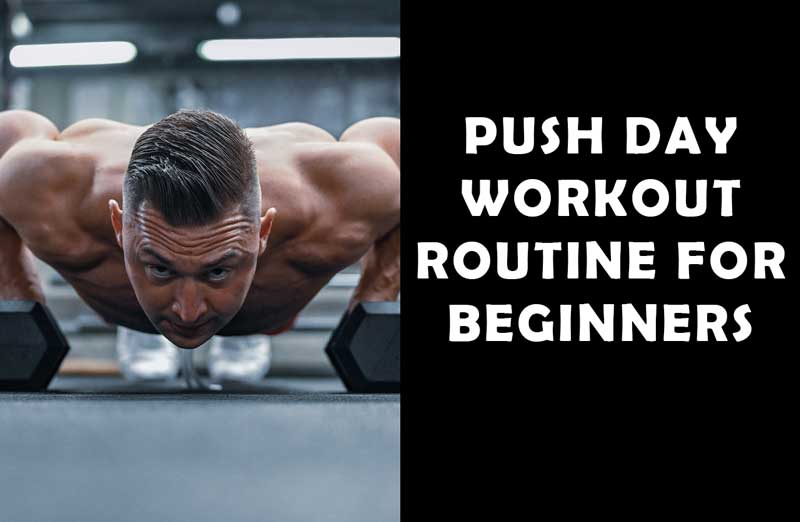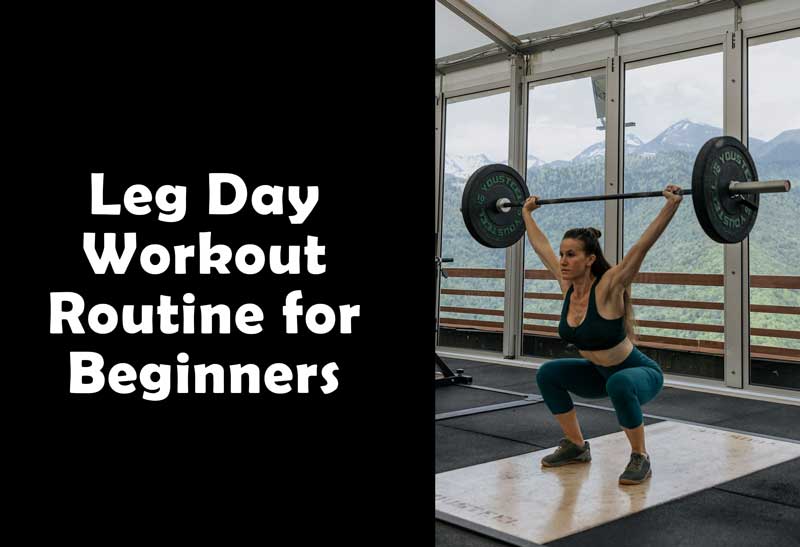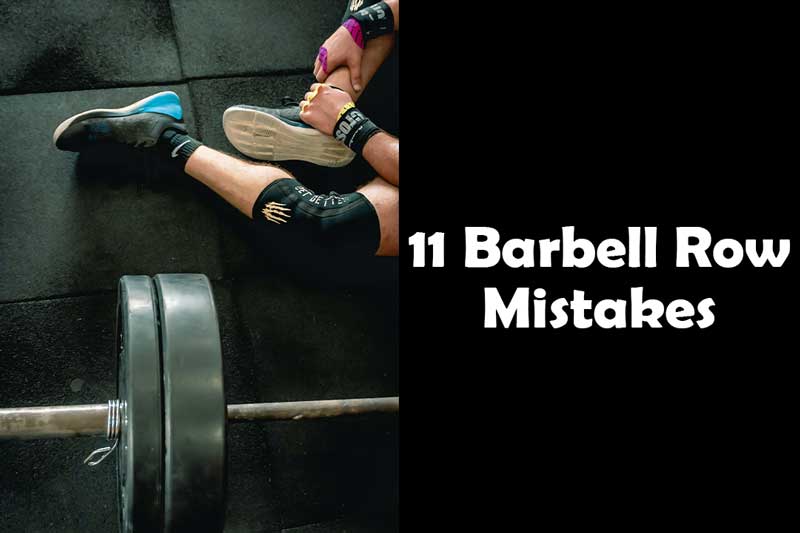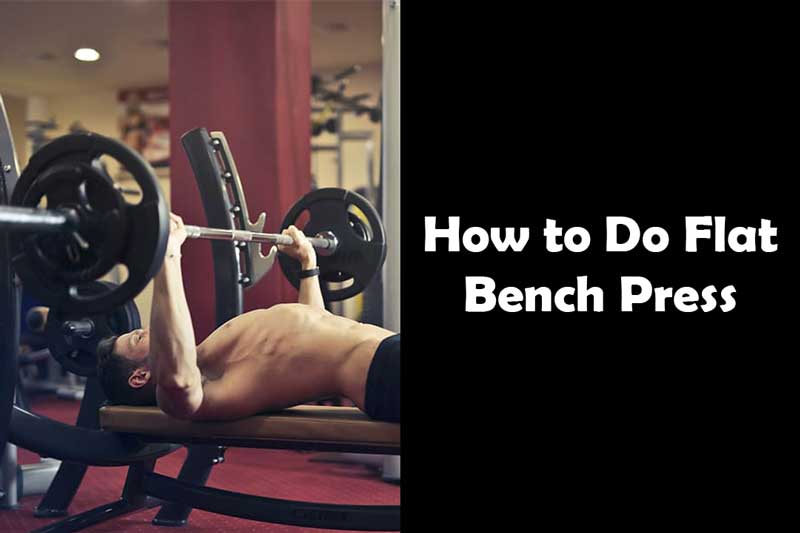Looking for a beginners push day workout routine and sculpt a strong, muscular upper body? Look no further! Whether you’re a fitness enthusiast or a beginner looking to embark on a new fitness journey, a push day workout routine is a fantastic way to build strength, enhance muscle definition, and boost your overall fitness level. In this article, we will guide you through the ins and outs of a push day workout routine, providing you with expert tips, essential exercises, and valuable insights to help you unleash your full potential.
What is a Push Day Workout Routine?
A push day workout routine is a type of strength training program that focuses on exercises that involve pushing movements. It primarily targets the muscles of the upper body, including the chest, shoulders, and triceps.
Push Day is a part of PPL Split. PPL stands for Push-Pull-Leg, which is Push Day, Pull Day and Leg day.
This routine is popular among beginners as it helps develop upper body strength, muscle tone, and overall fitness.
Benefits of a Push Day Workout Routine for Beginners
Let’s explore the benefits and importance of incorporating a push day workout routine into your fitness regimen.
1. Building Upper Body Strength
- Push day workouts are designed to challenge and strengthen the muscles of the chest, shoulders, and triceps.
- Regularly performing exercises like bench press, overhead press, and push-ups can lead to significant gains in upper body strength.
2. Muscle Definition and Tone
- By engaging in a push day workout routine, you can sculpt and define your chest, shoulder, and tricep muscles.
- Increased muscle definition enhances your overall physique and contributes to a more aesthetically pleasing appearance.
3. Postural Improvement
- Push day exercises such as bench press and overhead press engage the muscles responsible for maintaining proper posture.
- Regular practice can lead to improved posture, reducing the risk of postural imbalances and related discomfort.
Warm-up for Beginners Push Day Workout Routine
Before diving into the main workout, it’s crucial to warm up properly. Warming up prepares your body for exercise and helps prevent injuries.
Importance of warm-up before a workout
A warm-up increases blood flow to the muscles, raises body temperature, and enhances joint mobility. It also mentally prepares you for the upcoming workout and improves overall performance.
This further reduces risk of injuries as well as helps you in better muscle mind connection when doing the main workouts.
Recommended warm-up exercises
- Jogging or brisk walking for 5-10 minutes to increase heart rate.
- Arm circles.
- Shoulder rotations to loosen up the upper body.
- Dynamic stretches like arm swings.
- High knees to warm up the muscles.
6 Push Day EXERCISES for Beginners Workout Routine
1) Flat Bench Press
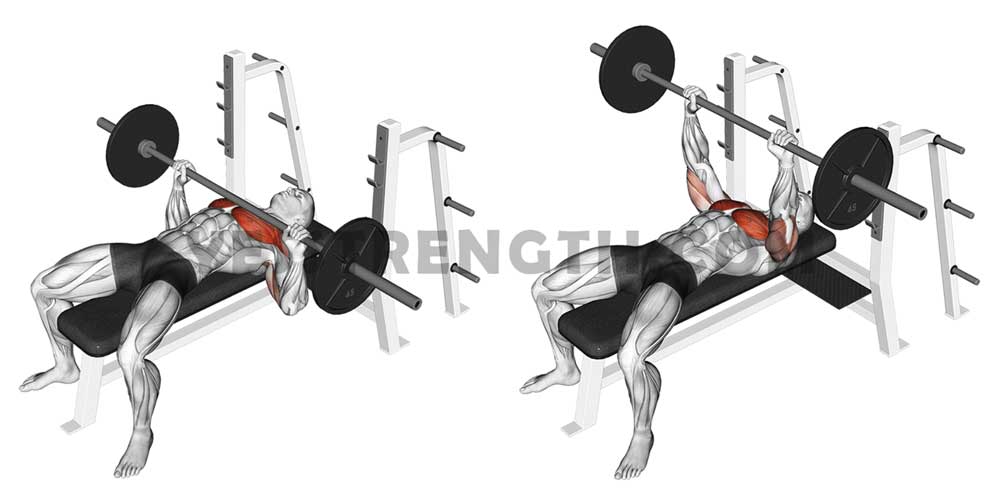
- Set up the bench: Position yourself on a flat bench with your feet firmly planted on the ground. Also, make sure the barbell is aligned with your chest.
- Lie down on the bench: Position your body on the bench with your back flat against it. Maintain a natural arch in your lower back and grip the barbell slightly wider than shoulder-width apart.
- Unrack the barbell: Lift the barbell off the rack and extend your arms fully. Moreover, ensure that your wrists are aligned with your forearms and your elbows are slightly bent.
- Lower the barbell: Slowly lower the barbell to your chest while keeping your elbows tucked in and your shoulders back and down. Aim to bring the barbell to the middle of your chest, just below your nipple line.
- Press the barbell upward: Push the barbell back up by extending your arms. Keep your feet grounded and maintain control throughout the movement.
2) Machine Fly
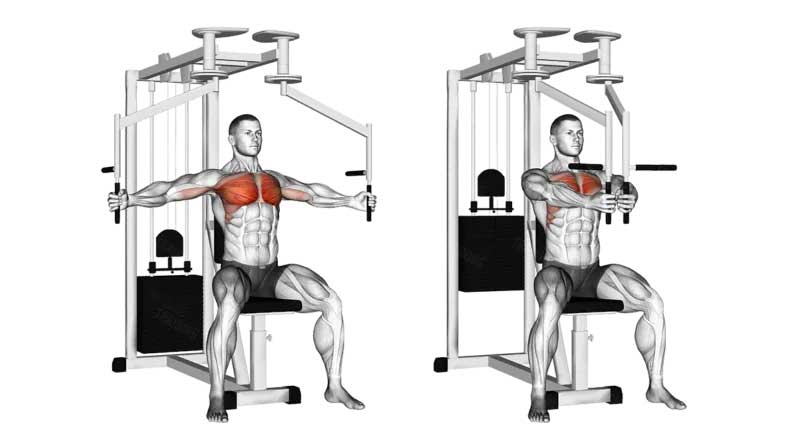
- Adjust the machine: Start by adjusting the seat height and the position of the handles to ensure proper alignment with your chest. The handles should be at the same height as your shoulders or slightly below.
- Sit on the machine: Sit down on the machine with your back pressed firmly against the backrest. Then, place your feet flat on the floor, shoulder-width apart, for stability.
- Grasp the handles: Extend your arms forward and grasp the handles with an overhand grip. Also, make sure your palms are facing inward and your wrists are in a neutral position.
- Engage your core: Activate your core muscles by drawing your belly button in toward your spine. This will help maintain stability throughout the exercise.
- Initiate the movement: Slowly and with control, open your arms out to the sides while keeping a slight bend in your elbows. Imagine hugging a large tree, focusing on the contraction in your chest muscles.
- Stretch and squeeze: Continue opening your arms until you feel a gentle stretch in your chest muscles. Avoid going too far or overstretching. Pause for a brief moment at the end of the movement to maximize the muscle contraction.
- Return to the starting position: Bring your arms back together in a controlled manner, reversing the movement. Maintain the same slight bend in your elbows as you return to the starting position.
3) Shoulder Press (Dumbbells)

- Stand with proper posture: Start by standing upright with your feet shoulder-width apart. Then, hold a dumbbell in each hand at shoulder level, palms facing forward.
- Brace your core: Engage your core muscles by drawing your belly button in toward your spine. Further, this will help maintain stability throughout the exercise.
- Initiate the movement: Push the dumbbells upward simultaneously by extending your arms fully. Keep your elbows slightly bent and avoid locking them out at the top of the movement.
- Lower the dumbbells: Slowly and with control, lower the dumbbells back to shoulder level, allowing your elbows to come down and create a 90-degree angle.
4) Lateral Raise
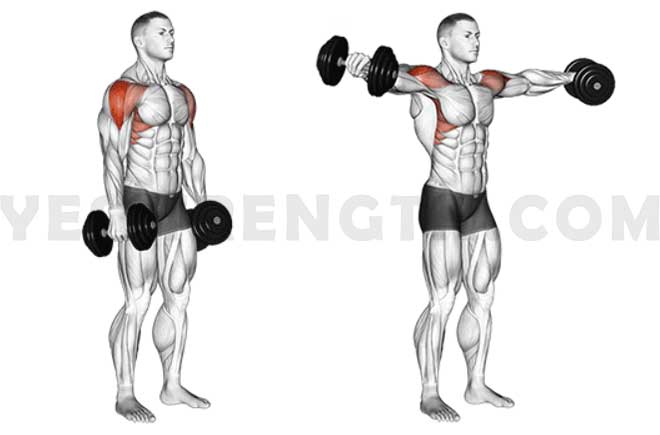
- Stand with proper posture: Start by standing upright with your feet shoulder-width apart. Then, hold a dumbbell in each hand, arms by your sides, and palms facing your body.
- Brace your core: Engage your core muscles by drawing your belly button in toward your spine. Maintain stability throughout the exercise.
- Initiate the movement: Raise your arms out to the sides, keeping a slight bend in your elbows. Continue the movement until your arms are parallel to the floor or slightly below shoulder level.
- Control the descent: Slowly lower your arms back down to the starting position, maintaining control and avoiding any swinging motions.
5) Tricep Dips
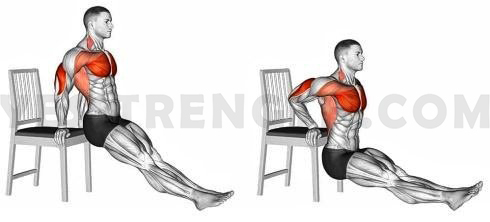
- Find a sturdy surface: Position yourself in front of a stable bench, chair, or parallel bars. Then, place your hands shoulder-width apart on the edge of the surface, fingers pointing forward.
- Set your starting position: Step your feet forward, extending your legs in front of you. Keep your heels in contact with the ground and your knees slightly bent.
- Lower your body: Begin to lower your body by bending your elbows. Aim to lower yourself until your upper arms are parallel to the ground or slightly below.
- Push back up: Push through your palms and extend your arms to raise your body back up to the starting position.
6) Push-ups
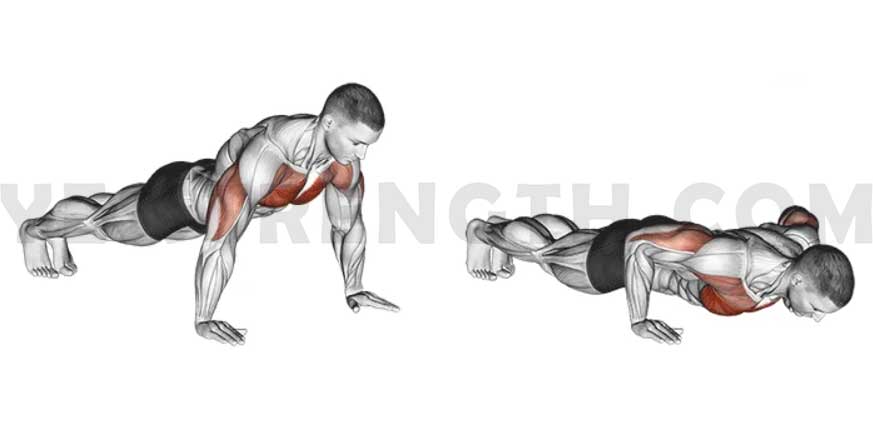
- Start in a plank position: Begin by positioning yourself face down on the floor. Place your hands slightly wider than shoulder-width apart, directly below your shoulders. Extend your legs straight behind you, resting on the balls of your feet.
- Engage your core: Activate your core muscles by drawing your belly button in toward your spine. Maintain a straight line from your head to your heels.
- Lower your body: Begin to lower your body by bending your elbows, keeping them close to your sides. Lower yourself until your chest is just above the ground or as far as you can comfortably go.
- Push back up: Push through your palms and extend your arms to raise your body back up to the starting plank position.
Sample Workout Routine For Push Day (Beginners)
Now that you have a solid understanding of the essential push exercises and how to perform them correctly, here’s a sample push day workout routine to kickstart your fitness journey:
| Warm Up: | |
| 1) Jogging/Brisk Walk | 5-10 minutes |
| 2) Arm Circles | 10 clockwise x 10 Anticlockwise |
| 3) Shoulder Rotations | 10 clockwise x 10 Anticlockwise |
| 4) Arm Swings | 20 Repetitions |
| 5) High Knees | 30-60 Seconds |
| Main Workouts: | |
| Exercises | Sets x Reps |
| 1) Flat Bench Press | 3 x 8-10 |
| 2) Machine Fly | 3 x 10-12 |
| 3) Shoulder Press | 3 x 8-10 |
| 4) Lateral Raise | 3 x 8-10 |
| 5) Tricep Dips | 3 x 12-15 |
| 6) Push Ups | 3 x 10-15 |
You might also like:
Pull Day Workout Routine for a Beginner
Workout Frequency and Progression
How often to do a Push Day workout
For beginners, it’s recommended to perform a push day workout routine 1-2 times per week, with at least one rest day between sessions. As you progress, you can increase the frequency to 2-3 times per week.
Progressive overload and tracking progress
To see continuous improvement, it’s important to progressively overload your muscles. This can be achieved by increasing the weight, reps, or sets over time. Keep track of your progress to ensure you’re challenging yourself and making gains.
Try increasing your weights gradually to avoid injuries.
Form and Technique
Importance of proper form
Maintaining proper form during exercises is crucial for maximizing results and preventing injuries. It ensures that the targeted muscles are effectively engaged and minimizes strain on other body parts.
Tips for maintaining correct form
- Keep your back straight and core engaged.
- Maintain a controlled and steady movement throughout the exercise.
- Use a full range of motion while maintaining control.
- Avoid using excessive momentum or swinging.
Rest and Recovery
Importance of rest days
Rest days are essential for muscle recovery and growth. They allow your muscles to repair and adapt to the stress of the workouts. Aim for at least one or two rest days per week.
Recovery strategies
- Get enough sleep to aid in muscle recovery.
- Incorporate stretching and foam rolling to alleviate muscle tension.
- Include active recovery activities like light cardio or yoga on rest days.
Nutrition and Hydration
Fueling your body for workouts
Eating a balanced diet with sufficient protein, carbohydrates, and healthy fats is crucial for supporting your workouts. Consume lean proteins, whole grains, fruits, and vegetables to provide the necessary nutrients.
Recommended pre- and post-workout meals
Pre-workout: Consume a meal or snack containing carbohydrates and protein around 1-2 hours before your workout. This provides energy and supports muscle repair and growth.
Post-workout: Have a meal or protein-rich snack within an hour after your workout to replenish glycogen stores and promote muscle recovery.
Common Mistakes to Avoid
Overtraining
One common mistake is overtraining by performing too many push day workouts without adequate rest. It can also lead to muscle fatigue, decreased performance, and increased risk of injuries.
Neglecting other muscle groups
Focusing solely on push day workouts without balancing it with pull and leg exercises can create muscle imbalances and hinder overall progress.
Injury Prevention
Importance of injury prevention
Preventing injuries is crucial for maintaining a consistent workout routine. Injuries can disrupt progress and lead to prolonged breaks from exercise.
Stretching and mobility exercises
Incorporate stretching exercises and mobility drills into your warm-up and cooldown routines. This improves flexibility, range of motion, and reduces the risk of injury.
Conclusion
In conclusion, a push day workout routine for beginners is an excellent way to build upper body strength, enhance muscle tone, and improve overall fitness. By incorporating exercises like bench press, shoulder press, push-ups, triceps dips and etc, you can target the chest, shoulders, and triceps effectively.
Moreover, remember to prioritize proper form, allow for sufficient rest and recovery, and fuel your body with a balanced diet. With consistency and progressive overload, you’ll make significant progress on your fitness journey.
FAQ
1) What other exercises can I include in a Push Day routine?
Other exercises you can include are shoulder upright rows, dumbbell chest presses, tricep extensions, and cable chest flies.
2) Can I do a Push Day routine if I’m a beginner?
Absolutely! A push day routine is suitable for beginners as it helps build foundational upper body strength.
3) How long should a Push Day workout last?
A typical push day workout can range from 45 minutes to an hour, including warm-up and cooldown.
4) Can I do cardio on Push Day?
While cardio can be beneficial for overall fitness, it’s recommended to separate cardio sessions from strength training workouts to allow for optimal recovery.
5) Can I combine Push Day with other workout routines?
Yes, you can combine push day with pull and leg workouts to create a well-rounded full-body training program. But it is not wise to include them in a single day.

